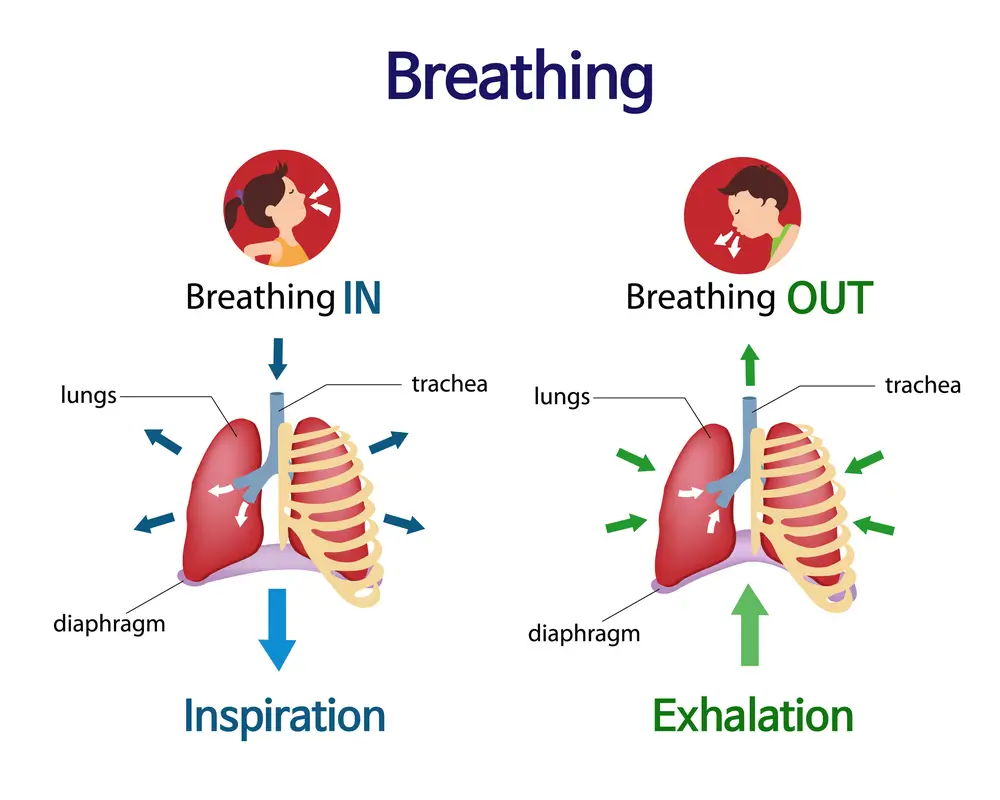The respiratory system includes the two important processes of inhalation and exhalation. The body exchanges oxygen and carbon dioxide through a collection of organs known as the respiratory system.
By bringing oxygen into the body and expelling carbon dioxide, breathing involves moving air in and out of the lungs to facilitate gas exchange with the internal environment.
The difference between exhalation and inhalation is that exhalation is the act of releasing air from the lungs, whereas inhalation is the act of bringing air into the lungs.
Now let’s learn the basic definition of inhalation and exhalation:
Table of Contents
Inhalation Definition

The act of taking in air, which contains oxygen and transports it to the lungs, is known as inhalation. It is an essential component of breathing, which is moving air into the lungs.
It is considered an active process and involves the first phase of respiration. The diaphragm and intercostal muscles contract during inhalation, increasing pressure in the lungs.
The chest cavity enlarges concurrently, resulting in a differential in pressure between the alveolus and the surrounding air, which then permits air to enter the lungs.
It is an automatic process that can be actively controlled or stopped but does not involve cognitive control or effort.
Now that you understand the inhalation definition, it’s time to learn about exhalation:
Exhalation Definition

Exhalation is the mechanism through which carbon dioxide-containing air is released from the lungs. Passive action is the term used to describe the final phase of respiration.
The diaphragm relaxes and travels toward the thoracic cavity during exhalation. This happens due to the internal intercostal muscles and the lungs’ elastic qualities, which lower the rib cage and reduce the volume of the thorax.
As a result, the outflow from the lungs is made possible by increased pressure in the thoracic cavity. Exhalation muscles, such as the abdominal and internal intercostal muscles, provide abdominal and thoracic pressure during forced exhalation (ex-blowing out a candle), pushing air out of the lungs.
Exhalation serves the primary function of exhaling carbon dioxide created during inhalation as a result of digestion and metabolism.
Exhalation is generally believed to take longer than inhalation. Because the air expelled from the lungs is heavier and includes more gas molecules than the air breathed.
Inhaling demands a muscular effort whereas exhaling only calls for relaxation of the body, exhaling may take longer than inhaling. It takes more time to relax than to contract.
However, during a forceful exhale, body muscles push air out of the lungs more quickly than during a regular inhalation.
Learn more: What is the Difference Between Melodramatic and Dramatic?
How and Why Do We Inhale and Exhale?

Before understanding how and why we inhale and exhale, we must first understand exhale meaning and inhale meaning:
Inhale Meaning
Inhale means to take air into your body, carrying all the elements inside through your nose, down your throat, and into your lungs.
Exhale Meaning
Exhale means the body blows out air through the nose after your body absorbs absorbable elements from it, usually oxygen.
The respiratory area in the brain is activated by blood pH, which is controlled by the carbonic acid in our bodies, which then sends the breathing signal down the body.
The diaphragm and occasionally the thoracic, shoulder, and neck muscles flex in response to the breathing signal to expand the rib cage and widen your lungs.
The blood pH rises when the lungs expand, carbonic acid leaks into them, the breathing muscles relax, and exhalation happens.
Differences Between Exhalation and Inhalation

There are many differences between exhalation and inhalation given below:
The primary difference between exhalation and inhalation is that exhalation is the process by which air is pulled out of the lungs by relaxing the respiratory system.
Whereas inhalation is breathing in which air is pushed into the lungs by creating negative pressure by tightening the diaphragm and respiratory muscles.
Another difference between exhalation and inhalation is that humans breathe in oxygen-rich air through the inhalation process and breathe out carbon dioxide-rich air through the exhalation process.
In comparison between inhalation vs. exhalation, inhaled air during inhalation has less carbon dioxide and more oxygen, which is utilized to produce energy.
On the other hand, exhaled air has less oxygen since it has been utilized for respiration and more carbon dioxide, which is a waste product of energy production.
20% of the oxygen in the air we breathe during inhalation is oxygen, and 0.03% is carbon dioxide. The remainder is almost entirely nitrogen. Exhaled air has a 3-4% decrease in oxygen content and a 3% increase in carbon dioxide.
In contrast to inhalation, exhalation takes longer than inhalation to complete. Inhalation takes less time than exhalation. Air pressure decreases after inhalation (below atmospheric pressure). There is an increase in air pressure during exhalation.
Inhalation Vs. Exhalation

If we do a comparison between inhalation vs. exhalation, the inhale uses muscular force to expand your upper body so that air flows into your lungs. As your lungs expand, oxygen diffuses into your body, and carbonic acid diffuses to the lungs. Your blood pH goes up as that acid diffuses out.
On the exhale, the muscles used to inhale relax, and the lungs return to the rest state, pushing air out and carrying the carbonic acid.
The oxygen concentration in inhaled air is high, while the carbon dioxide content is low, and the opposite is true for exhaled air.
What are the Differences Between Exhalation and Inhalation?
Highlighting the main differences between exhalation and inhalation in the following table:
| Inhalation | Exhalation |
|---|---|
| The act of taking air into the lungs is known as inhalation. | The act of exhaling involves releasing air from the lungs. |
| The act of inhaling is active process | The act of exhaling is a passive process. |
| During inhalation, the diaphragm contracts and moves downward, flattening out. | During exhalation, the diaphragm relaxes and moves upward to assume a dome-shaped shape. |
| Inhalation increases the size of the chest cavity. | Exhalation decreases the size of the chest cavity. |
| Intake of oxygen-rich air into the blood occurs. | A release of carbon dioxide occurs during exhalation. |
Conclusion
It’s crucial to remember that your body needs both inhalation and exhalation to function correctly. For the lungs to work effectively and supply the body with air, when necessary, exhalation also helps to keep them healthy.
Because many different nutrients and oxygen, which are necessary for everything from breathing to cardiovascular health, come out of inhaling and exhaling, a person must have a healthy body.
The difference between exhalation and inhalation is that a process that requires energy is inhalation. Exhalation, however, is a passive action that doesn’t require any energy.


